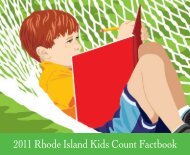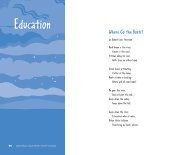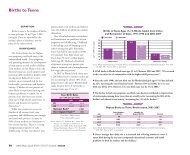2010 Rhode Island Kids Count Factbook
2010 Rhode Island Kids Count Factbook
2010 Rhode Island Kids Count Factbook
Create successful ePaper yourself
Turn your PDF publications into a flip-book with our unique Google optimized e-Paper software.
Federal Financing<br />
After-School Care<br />
◆ The Child Care and Development<br />
Block Grant (CCDBG) is a major source<br />
of federal funding for child care. States<br />
receive funding based on an allocation<br />
formula and can use these funds for child<br />
care subsidies for low-income children<br />
ages 12 and under and to improve the<br />
quality of child care. In 2008 in the U.S.,<br />
approximately 34% of children receiving<br />
child care subsidies were school-age,<br />
compared with 40% in <strong>Rhode</strong> <strong>Island</strong>. 16<br />
◆ <strong>Rhode</strong> <strong>Island</strong>’s Fiscal Year <strong>2010</strong> enacted<br />
budget included $45.4 million for child<br />
care subsidies, of which $38.9 million<br />
came from federal sources, primarily the<br />
Child Care and Development Block Grant<br />
(CCDGB) and TANF, and $6.5 million<br />
from state general revenue. 17<br />
Expanded Learning Opportunities<br />
◆ The 21st Century Community<br />
Learning Centers program provides<br />
funding for after-school programs serving<br />
primarily students attending Title I<br />
schools (schools with high concentrations<br />
of disadvantaged students). In Federal<br />
Fiscal Year <strong>2010</strong>, <strong>Rhode</strong> <strong>Island</strong> will<br />
receive $5.7 million to serve<br />
approximately 5,700 children at 51<br />
after-school centers. 18<br />
Table 39.<br />
Licensed School-Age Child Care for Children<br />
Ages Six to 12, <strong>Rhode</strong> <strong>Island</strong>, 2009<br />
NUMBER OF CHILDREN NUMBER OF NUMBER OF<br />
CITY/TOWN AGES 6 TO 12 PROGRAMS SLOTS<br />
Barrington 2,064 5 180<br />
Bristol 1,784 4 162<br />
Burrillville 1,672 3 213<br />
Central Falls 2,190 4 319<br />
Charlestown 717 1 26<br />
Coventry 3,431 7 273<br />
Cranston 7,115 19 666<br />
Cumberland 3,135 4 270<br />
East Greenwich 1,581 4 141<br />
East Providence 4,292 10 503<br />
Exeter 684 3 74<br />
Foster 489 1 18<br />
Glocester 1,105 1 10<br />
Hopkinton 802 1 52<br />
Jamestown 576 1 51<br />
Johnston 2,490 5 65<br />
Lincoln 2,206 6 301<br />
Little Compton 322 1 26<br />
Middletown 1,787 6 206<br />
Narragansett 1,144 1 60<br />
New Shoreham 69 0 0<br />
Newport 2,056 4 260<br />
North Kingstown 2,823 9 319<br />
North Providence 2,444 8 545<br />
North Smithfield 988 1 100<br />
Pawtucket 7,477 9 836<br />
Portsmouth 1,839 3 134<br />
Providence 18,592 33 2,699<br />
Richmond 830 1 52<br />
Scituate 1,102 1 29<br />
Smithfield 1,653 5 129<br />
South Kingstown 2,630 3 139<br />
Tiverton 1,452 2 95<br />
Warren 1,032 2 92<br />
Warwick 7,630 15 784<br />
West Greenwich 592 2 28<br />
West Warwick 2,618 6 323<br />
Westerly 2,160 3 90<br />
Woonsocket 4,373 10 551<br />
Core Cities 37,306 66 4,988<br />
Remainder of State 64,640 138 5,833<br />
<strong>Rhode</strong> <strong>Island</strong> 101,946 204 10,821<br />
School-Age Child Care<br />
Source of Data for Table/Methodology<br />
Number of children ages six to 12 years old is from the<br />
U.S. Census Bureau, Census 2000 Summary File 1.<br />
Department of Children, Youth and Families, number of<br />
licensed school-age child care programs and slots for<br />
children ages six to 12 as of December 2009. These<br />
numbers do not include certified family child care<br />
home slots, informal child care arrangements, and<br />
community programs for youth ages six and older<br />
that do not require licensing by the state. Licensed<br />
school-age child care programs also provide services<br />
to five year-old children who are enrolled in<br />
kindergarten.<br />
References<br />
1<br />
U.S. Census Bureau, American Community Survey,<br />
2006-2008. Selected Economic Characteristics, <strong>Rhode</strong><br />
<strong>Island</strong> and United States, 2006-2008.<br />
2,4<br />
After-school worries: Tough on parents, bad for business.<br />
(2006). New York, NY: Catalyst.<br />
3<br />
Lawrence, S. & Kreader, J. L. (2006). School-age child<br />
care arrangements. Child Care & Early Education<br />
Research Connections, No. 4. Retrieved February 6,<br />
2007, from www.childcareresearch.org<br />
5<br />
Hall, G., Yohalem, N., Tolman, J. & Wilson, A. (2003).<br />
How afterschool programs can most effectively promote<br />
positive youth development as a support to academic<br />
achievement. Wellesley, MA: National Institute on<br />
Out-of-School Time, Wellesley Centers for Women,<br />
Wellesley College.<br />
6<br />
Felner, R. D. (2008). 2007-2008 Student reports of after<br />
school supervision, <strong>Rhode</strong> <strong>Island</strong> SALT Survey. Rock<br />
<strong>Island</strong>, IL: National Center for Public Education and<br />
Prevention.<br />
7,8<br />
Making the case: A 2009 fact sheet on children and youth<br />
in out-of-school time. (2009). Wellesley, MA: National<br />
Institute on Out-of-School Time, Wellesley Centers<br />
for Women, Wellesley College.<br />
9<br />
Miller, B. M. (2003). Critical hours: Afterschool programs<br />
and educational success. Brookline, MA: Nellie Mae<br />
Education Foundation.<br />
10<br />
<strong>Rhode</strong> <strong>Island</strong> Department of Children, Youth and<br />
Families, school-age child care slots, 2009.<br />
11<br />
National Afterschool Association, accredited programs,<br />
2009.<br />
(continued on page 170)<br />
<strong>2010</strong> <strong>Rhode</strong> <strong>Island</strong> KIDS COUNT <strong>Factbook</strong> 129






